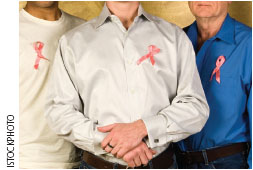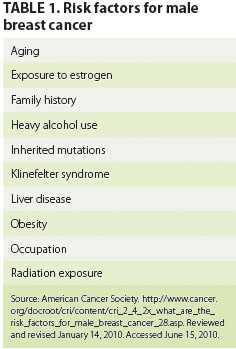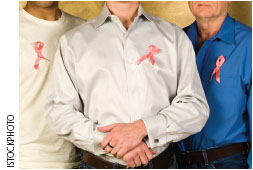Men do get breast cancer, although certainly not as frequently as women do, with male breast cancer (MBC) accounting for fewer than 1% of breast cancer diagnoses worldwide.1 From 1973 through 2005, there were a total of 5,494 cases of male breast cancer and 835,000 cases of female breast cancer, according to the Surveillance, Epidemiology, and End Results (SEER) registry.1 Men are often older than 60 years when their disease is diagnosed, and the incidence is apparently highest among black men.1
MORE ADVANCED AT DIAGNOSIS
At diagnosis, the man with breast cancer may have more advanced disease than a woman does, usually because he does not realize that the breast lump he has found or the sporadic pain he feels should be addressed or because he is embarrassed to discuss it with his health care provider. The lesion might also be hidden by gynecomastia, although that condition is not associated with MBC. That so many men delay contacting their health care providers is unfortunate because invasive ductal carcinomas comprise the majority of tumors (85%-95%) in men, followed by ductal carcinoma in situ (5%-10% of tumors).2
GENETIC PREDISPOSITION
 Approximately 15% to 20% of men with breast cancer have a family history of breast or ovarian cancer (Table 1). Estimates are that about 10% of them usually have a genetic predisposition, most often being carriers of the BRCA2 gene. The estimated lifetime risk of breast cancer is 5% to 10% among male BRCA2 carriers, compared with a general population risk of 0.1%.3
Approximately 15% to 20% of men with breast cancer have a family history of breast or ovarian cancer (Table 1). Estimates are that about 10% of them usually have a genetic predisposition, most often being carriers of the BRCA2 gene. The estimated lifetime risk of breast cancer is 5% to 10% among male BRCA2 carriers, compared with a general population risk of 0.1%.3
HOW CAN I GET BREAST CANCER? I’M A MAN!
Statistics tell an epidemiologic story, but they don’t tell the patient’s story. The numbers reinforce how rare male breast cancer is, but they don’t describe what it is like for a man to live with and be treated for what is perceived as a woman’s disease. Fortunately, a number of men with breast cancer have written about their experiences for the benefit of others. Some male breast cancer patients have given interviews, and several have established support groups or blogs on the Internet.
When a man learns he has breast cancer, he reacts to the news the way a woman does, only more so: with shock, disbelief, and the feeling of numbness. “How can I get breast cancer? I’m a man!” “Maybe there’s a mistake in the diagnosis.” “What now?”
 The difficult process of diagnosis is unusually challenging for a man with MBC, as can be expected in a world awash in pink ribbons. Here is a description from the patient-blogger site Dr. Z’s Zombie-A-Go-Go:
The difficult process of diagnosis is unusually challenging for a man with MBC, as can be expected in a world awash in pink ribbons. Here is a description from the patient-blogger site Dr. Z’s Zombie-A-Go-Go:
My doctor looked at it and recommended further testing. And here’s where the indignity kicked in. Believe me when I say that there is nothing more emasculating then being a man and having to go get a [mammogram]. The waiting room, the exam room, even the consultation room are all festooned in the ubiquitous pink imagery and ribbons of the woman’s breast cancer movement. And there is nothing so embarrassing and cringe inducing than being a five foot ten inch, 240 pound, shaved head man with a bad attitude who has to sit in the waiting room —all while explaining to the young, vacuous, and gum snapping female receptionist, “No, it’s not a mistake. I’m supposed to be here for a mammogram. And thanks for letting everybody in the waiting room know.”
The indignity continued.
The mammogram was inconclusive —and so they immediately walked me over, shirtless and wearing a paper gown made for a petite woman—to get an ultrasound…. Afterwards, I was allowed to get dressed…. After ten minutes, the technician who’d done the ultra sound (wearing nursing scrubs with more of those Pepto-Bismol pink ribbons on it) came back….4
TREATMENT
The unique aspect of being a man with breast cancer fades rather quickly, and the man with MBC focuses on the question asked by every patient who has been told that he or she has cancer: what is the most effective treatment? There are the same considerations as for a woman with breast cancer.
Axillary node involvement is found in about half of men with MBC. Since men have less breast tissue than women and men have a mean tumor size of 2.4 cm, the most common surgical procedure for male breast cancer is mastectomy. Among men, 70% of patients have modified radical mastectomies, 8% to 30% have mastectomies, 5% to 14% have total mastectomies, and up to 13% are treated with lumpectomies with or without radiation.5 For men with node-positive tumors, chemotherapy plus tamoxifen and other hormonal therapy can increase survival as effectively as it does in women with breast cancer.
